Barbara Gittings & Kay Lahusen — Part 2
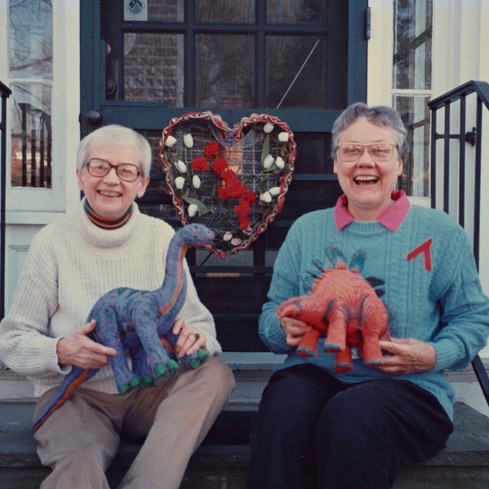 Kay Lahusen (at left) and Barbara Gittings in 1995 on the steps of their house in West Philadelphia, Pennsylvania. Credit: Photo by Ray Harriman. Courtesy of the Manuscripts and Archives Division, The New York Public Library.
Kay Lahusen (at left) and Barbara Gittings in 1995 on the steps of their house in West Philadelphia, Pennsylvania. Credit: Photo by Ray Harriman. Courtesy of the Manuscripts and Archives Division, The New York Public Library.Episode Notes
The story behind the photograph of Barbara Gittings and Kay Lahusen on the steps of their house holding dinosaur dolls offers the perfect setup for this second Making Gay History episode with Barbara and Kay where they share two stories from their activism in the early 1970s. In their first MGH episode, Barbara and Kay told us how they met, about their early work with the Daughters of Bilitis, and their partnership with Frank Kameny leading the first protests in front of the White House beginning in 1965.
But in the aftermath of the June 1969 Stonewall riots in New York City, Barbara and Kay found themselves challenged by younger activists new to the movement. And that’s where the dinosaurs come in.
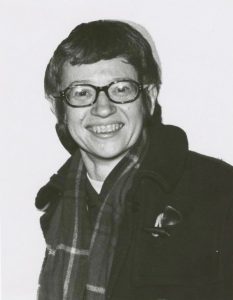
As Kay explained in a 2016 telephone conversation with MGH host Eric Marcus, Barbara and Frank went to a Gay Liberation Front (GLF) meeting in New York City shortly after the Stonewall uprising and were challenged by one of the leaders of that new organization who asked them what entitled them to be there. Barbara, who was shocked and angered by the question, said, “I’m gay, that’s what entitles me.” Another person at the meeting who recognized them, called Barbara and Frank “dinosaurs” and “lackeys of the establishment.”
A few months later Kay bought two stuffed dinosaur dolls from a floral shop in Philadelphia. She said that she bought them because: “We decided we’d make lemonade out of lemons. We used to carry those dinosaurs around to meetings of other gay organizations and conferences in the years that followed. We were dinosaurs in a way, but we were good dinosaurs. Every movement has people who you can call dinosaurs because they started in the old days. But if you started in the early days, so what?”
To learn more about Barbara and Kay’s pre-Stonewall lives, have a listen to their first episode from season one and explore that episode’s show notes. We also recommend Frank Kameny’s episode and show notes from season one, as well.
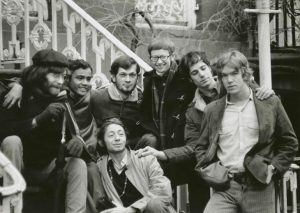
In the aftermath of the Stonewall uprising, Kay and Barbara found new ways to pursue their passions as “gay fanatics.” Kay was one of the original 12 members (along with Morty Manford) of the Gay Activists Alliance (GAA), a gay liberation group that was founded six months after the Stonewall uprising by dissident members of the more radical and anarchic Gay Liberation Front (GLF).
Kay participated in GAA protests, called “zaps,” and reported for the GAY newspaper. And, as she had in the past, she also worked as a photographer, recording this new era of gay liberation. She also co-authored a book with Randy Wicker called The Gay Crusaders.
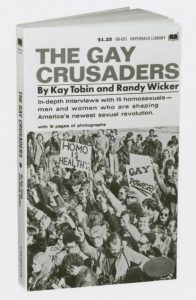 Barbara focused her attention on the American Library Association. While she wasn’t a librarian, she’d had a lifelong love of books and built an extensive collection of books about lesbian and gay people. She and Kay were also very active in efforts to get the American Psychiatric Association to remove homosexuality from the Diagnostic and Statistical Manual’s list of mental illnesses. Barbara and Kay’s work with the American Library Association and the American Psychiatric Association are the focus of this second episode.
Barbara focused her attention on the American Library Association. While she wasn’t a librarian, she’d had a lifelong love of books and built an extensive collection of books about lesbian and gay people. She and Kay were also very active in efforts to get the American Psychiatric Association to remove homosexuality from the Diagnostic and Statistical Manual’s list of mental illnesses. Barbara and Kay’s work with the American Library Association and the American Psychiatric Association are the focus of this second episode.
Watch Barbara deliver a speech at New York City’s 1973 Pride march and rally in this LoveTapesCollective video.
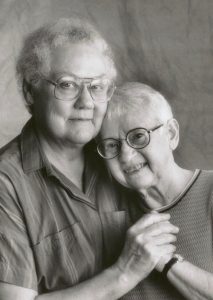
Barbara and Kay remained a couple until Barbara’s death in 2007. Kay died in 2021. She did not remember what happened to the dinosaurs.
For more information on what you’ve heard in this episode, have a look at some of the resources that follow below.
———
Clarification: In this episode, MGH host Eric Marcus notes that the American Psychiatric Association voted in 1973 to remove homosexuality from the DSM’s list of mental illnesses. It was a bit more complicated than that. As Matthew Riemer and Leighton Brown, the men behind the @LGBT_History Instagram account, explained in a post that accompanied the photograph that we include below of the 1972 “Gay Proud and Healthy” exhibit created for that year’s APA annual meeting:
In December 1973, gay rights pioneers … secured a seminal victory when the American Psychiatric Association’s board of trustees ratified the Nomenclature Committee’s recommendation to remove homosexuality from the Diagnostic and Statistical Manual of Mental Disorders (DSM) … The removal of homosexuality from the DSM, however, was soon challenged by a dedicated group of anti-gay APA members.
In an unorthodox procedural move, the angry faction, known as the Ad Hoc Committee Against the Deletion of Homosexuality from DSM-II, moved to put the decision to a vote of the entire APA membership; an important scientific decision, in other words, was to be decided by popular vote. On April 9, 1974 … results of the months-long balloting process were announced, with nearly 60 percent of APA members affirming the decision to remove homosexuality from the DSM.
———
Watch a 30-second clip of Barbara Gittings from a 2006 presentation about the “Hug a Homosexual” booth from the 1971 American Library Association annual conference.
In 2013, Vermont librarian Jessamyn West stumbled across a photograph of the “Hug a Homosexual” booth, wrote a piece about her discovery of what it was about, and posted it on her professional blog, librarian.net (which has been “putting the rarin back in librarian since 1999”).

Barbara’s compatriot in the Hug a Homosexual booth was Alma Routsong, who wrote the novel Patience and Sarah. Historian Jonathan Ned Katz, who wrote the landmark 1976 book Gay American History, interviewed Alma Routsong in 1975. You can read a transcript of that interview here. You can also watch a 1990 interview with Alma from the Lesbian Herstory Archives Daughters of Bilitis Video Project.
Barbara became the coordinator of the “gay caucus” within the American Library Association in 1971. That group is now called the Gay, Lesbian, Bisexual, and Transgender Round Table (GLBTRT).
Barbara and Kay’s oral history can be found in Eric Marcus’s book Making Gay History, which was given the 1993 Stonewall Book Award for Nonfiction by the American Library Association.
Dr. H. Anonymous (or Dr. Henry Anonymous), the masked man in the photograph of the panel at the 1972 American Psychiatric Association convention in 1972, was Dr. John Fryer. You can read about him in this article, which was published on March 22, 2003, a month after his death.
You can see a copy of Dr. Henry Anonymous’s nine-page handwritten May 2, 1972 speech that he delivered at the American Psychiatric Association panel discussion with Barbara Gittings and Frank Kameny here. Dudley Clendinen wrote Dr. John Fryer’s obituary for the New York Times. Clendinen was the author along with Adam Nagourney of Out for Good: The Struggle to Build a Gay Rights Movement in America.
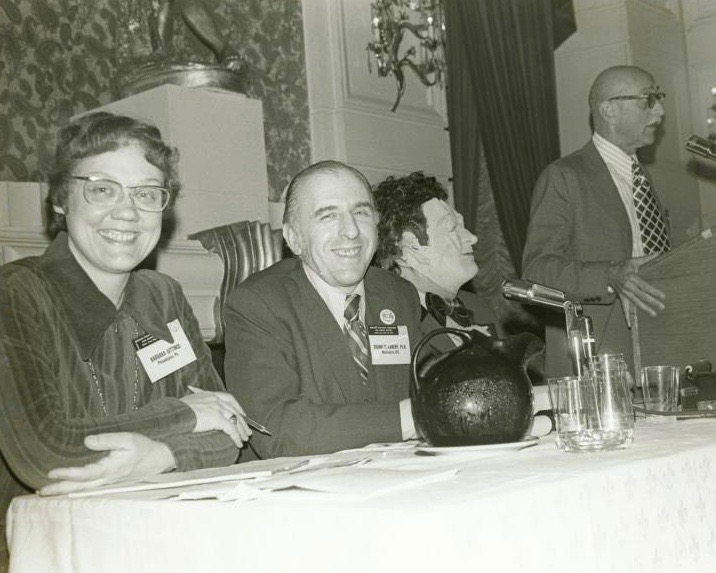
To find out how Dr. Evelyn Hooker got the ball rolling in the effort to prove that gay people were not by definition mentally ill, listen to her season one episode in which she tells us about the 1956 American Psychological Association convention at which she presented her landmark study.
———
Episode Transcript
Eric Marcus Narration: I’m Eric Marcus and this is Making Gay History.
In this episode you’re going to meet Barbara Gittings and Kay Lahusen. For those of you who got to know Barbara and Kay last season, you’re going to get to know them a little better. For those of you are are new to this dynamic duo, I encourage you to go back and listen to their first episode where you’ll hear how these happy warriors, self-described gay fanatics, and life partners met and got their start in the early homophile movement of the 1950s and ‘60s.
This episode picks up after the 1969 Stonewall uprising, which lit the match that transformed the small-scale homophile movement into a national gay liberation campaign. Within a very short time, the early movement organizations and activists faded into history as younger, more militant LGBTQ people picked up the ball and ran with it.
But anyone who knew Barbara and Kay would know they’d never go quietly into the night. And after first having to defend themselves as legitimate members of the movement at a public meeting of the newborn Gay Liberation Front organization, they got down to business and focused on the things that interested them. And lucky for us, they brought all their passion, creativity, humor, and valuable experience with them.
Barbara focused on her interest in books and the American Library Association. For Barbara, like almost everyone I interviewed, books were the only place where LGBTQ people could find themselves.
Kay photographed the revolution and co-authored a book called The Gay Crusaders. And together they worked with Frank Kameny to demolish the belief that homosexuals were by nature mentally ill. It’s a battle that ended when the American Psychiatric Association voted in 1973 to remove homosexuality from its list of mental illnesses in the DSM. That’s the Diagnostic and Statistical Manual, which is the mental health profession’s bible for deciding what is and what is not mental illness.
So we’re back at Barbara and Kay’s cozy house in Philadelphia. The microphone is still clipped to Barbara’s blouse. But Kay can’t sit still so I give up trying to keep her tethered to the tape recorder. From the kitchen she hears everything and joins the conversation when she’s got something to add.
———
Date: Monday, December 18, 1989
Location: West Philadelphia, Pennsylvania
Eric: Gittings-Tobin, tape two, side one.
Barbara: I am not a librarian. But I’ve always had a great respect, a profound respect for the literature and for what it says and doesn’t say about us, and for how it makes us feel about ourselves and how it makes other people feel about us. Because when I first wanted to find out what it meant to be gay, after I first put the label on myself, being a reasonably well-educated girl, I thought, oh well, I’ll go to the library. Ha, ha, ha. Famous last words. I went to the library and I went to another library, and yet another. And I found very little information and most of it was false. It rang false. Even if I knew it was me they were talking about it didn’t ring true. There was nothing about love. And it was all so strange. Clinical sounding, very clinical. And then later I found the novels of homosexuality and they made me feel a lot better, because even though these were fictional characters, they were more like real people. And I started collecting gay books. There were no gay bookstores then. I went to regular used bookstores and searched for gay titles.
Anyway, I heard by accident in 1970 that a gay group had formed in the American Library Association.
Kay: You were doing the broadcast for WBAI.
Barbara: I was doing gay news once a week, 15 minutes worth of gay news on WBAI in New York. And one day in the… in our box at the station was a little notice saying that a group of gays had formed in the American Library Association and they were meeting in New York and were looking for others to join them. Books! Libraries! That rang bells for me. So I went to a meeting of the group and I was welcomed. And they were planning a massive… one of those big bibliographies, everything ever written about the subject. But that of course was going to take some time. And what they needed was a short manageable list of the most positive materials that could be distributed at the next small mid-winter conference of the ALA.
Kay: Eric, the important point is that the positive materials could all fit on one legal-sized flyer.
Barbara: Letter-size, yet. Letter-size.
Kay: Letter-size. One side. Was that it? One or two, I can’t remember.
Barbara: It happened that I knew, at that point, as much about the existing literature as anyone else in the group, even though I was not a librarian. Just from my reading. So I helped put together that first group. And I believe it had 32 entries. And it all fit on one letter-size sheet. You know, two sides. Midwinter meeting that year was in Los Angeles and I couldn’t afford to go, but I sent the bibliography out. Others did the leafleting.
And then the next big annual meeting was to be in Dallas, 1971. And I did travel to Dallas for that and took part in the activities of the group. Well, we had a lot… we gave the first gay book award. We even got some money from our parent group in the ALA, the Social Responsibilities Round Table, to bring the author… to pay for the, her air fare to come to Dallas to accept the award in person.
Eric: What was the book?
Barbara: It was then called Patience and Sarah. Well, no, it was retitled Patience and Sarah. It was then called A Place of Our Own?
Kay: A Place For Us?
Barbara: A Place For Us. That was the original title.
Eric: What was the author’s name?
Barbara: Isabelle Miller, but that’s actually the name of Alma Routsong.
Anyway, we had a talk by Michael McConnell a gay librarian who had lost his job when he was public about being gay. He’d actually been hired for the job and then they found out that he and his lover [Jack Baker] had applied for a marriage license and they suddenly, ech, off.
And we had a pair of talks under the charming title, “Sex and the Single Cataloguer: New Thoughts on Some Unthinkable Subjects,” which was about the funny subject headings that gay materials are classified under. And we had an expanded edition of the gay bibliography, which had first been done six months before for hand out. And this time it had a big “Gay is Good” logo at the head. And this time it was expanded to a legal-size sheet. And all of these are clearly related to books in libraries, right?
Kay: And not only would we leaflet, we’d plaster them up in elevators and in…
Barbara: Yes.
Kay: …and in the elevator waiting corridors and uh…
Eric: During the convention.
Barbara: During the convention.
Kay: We put them all around, very aggressive with them. They would say, “Oh, there are those gay task force people again.”
Barbara: All of these things didn’t quite draw the attention that they deserved. All these professional interest activities didn’t draw the professional interest that we thought they would. So we did one thing that was not at all connected with libraries and it really made them sit up and take notice. That was our gay kissing booth. We had the first-ever gay kissing booth.
Eric: At the ALA convention?
Barbara: At the ALA convention.
Kay: In the convention hall.
Barbara: What happened was we, well we decided to bypass books and show gay love, live! So we called it, “Hug a Homosexual.” And we stripped it down to the bare gray curtains and we had a sign up, “Men Only” at one end. And “Women Only” at the other. And we stationed ourselves…
Kay: Same-sex kisses…
Barbara: …all four of us, under the signs, to give free, mind you, free, same-sex kisses and hugs. Well, let me tell you, the aisles were jammed, but nobody came into the booth.
Kay: And Life magazine was there.
Barbara: Life magazine photographer was there. Two Dallas television stations had sent camera crews.
Kay: Right, the lights were going on….
Barbara: People were rather intimidated. Yes, the lights were on and all these people jammed in the aisles, craning their necks to see the action, but nobody wanted to take part. So we did the action. We kissed and embraced each other for two hours. We handed out copies of the bibliography. We called out encouragement. We kissed and hugged each other some more. Alma Routsong was an absolute peach. She and I were on the female end. And a couple of the men were on the other and we did all this ourselves. That really put us on the map.
Kay: So there we were on the 6 o’clock news and the library people were livid. They said, “We have all these famous authors here and all they cover is this kissing booth!”
Babara: They put us on the 6 o’clock news. They put us again on the 11 o’clock news and again the next morning. This was news! It was wonderful. Really, our spirits soared because we… You know, really, the booth also had a message that was useful in any arena. And that is that gay people are not willing anymore to be subject to a special double standard. We should have the same right to express our affection publicly as heterosexuals have. No more, but no less.
Eric: This was very bold.
Barbara: For 1971, you better believe it it was bold.
Kay: It was revolutionary.
Barbara: We thought it was marvelous. It was really, it was a thrill. And the reaction. Oh, they wrote about us in the library press for the next six months! We couldn’t have asked for better publicity… free publicity.
Eric: I want to show you a photograph, which you’re probably familiar with.
Kay: Is this the picture?
Barbara: Oh, this is Dr. Anonymous at the American Psychiatric Association.
Kay: I took that picture.
Barbara: That’s Kay’s picture, yes.
Kay: That’s mine.
Barbara: That’s Kay’s photo.
Kay: I’ll show it to you from my file upstairs.
Barbara: Well, at the left is myself, Barbara Gittings. Next to me is Franklyn Kameny. And we were the two non-psychiatrist gay panelists.
Eric: What was this event that you were speaking at?
Barbara: This was the American Psychiatric Association’s annual conference.
Eric: Which was in May of 1972.
Kay: I was shooting for Gay newspaper at the time. That appeared in there.
Barbara: Frank and I… The story behind this is that Frank and I had been asked to be on a panel at the 1972 conference and Kay said—this was all Kay’s doing—she said, “Well, look…” Oh, yes, there were to be a couple of psychiatrists, I think Judd Marmor was one of them. And she said, “Look, you have psychiatrists who are not gay on the panel. And you have gays who are not psychiatrists on the panel. But what you’re lacking on the panel is gay psychiatrists. Those who are both.” And she said, “Why don’t we try to get a gay psychiatrist?” Well, the moderator was perfectly agreeable. But he said, you know, “Find somebody for me.” And I made a number of calls to some of the people I had made some contacts with and nobody yet was quite willing to be that public.
Eric: Why? What would have happened if someone who was that public?
Barbara: They feared damage to their careers. But finally I talked with this one man who said, “Well, I will do it provided I am allowed to wear a wig and a mask and use a distort microphone.” And that’s what he did. And he came on the… He was billed in the program as “Dr. H. Anonymous.” That was the way he wanted to be billed. And he was going to talk about what it was like to have to live in the closet because of career constraints as a gay psychiatrist.
It went off marvelously! The house was packed. Dr. H. Anonymous came in through the back.
Kay: Frank Kameny was ravenly against it. He didn’t want anyone in a mask. He wanted it to be up front.
Barbara: I know, but it went off so well that he had to admit afterwards that it was a great gambol. It was a great gambol. Look at the smile on his face. After all it went off so well.
Eric: What were the other two…
Barbara: “Psychiatry, Friend or Foe to Homosexuals, A Dialogue” was the title.
Eric: The title of the, uh, panel.
Barbara: The title of the panel that had Frank and me and Dr. H. Anonymous and Dr. Marmor.
From 1967 when I made my first public lecture to a straight audience, and I had to deal constantly with, with people’s conviction that we were sick simply because they had heard some psychiatrist say so or they had heard a report of the infamous Bieber study, that badly flawed study which didn’t even get examined critically in the profession and which got ballyhooed to the public. That was the one that promoted the idea that gay men become gay because of the absent, distant father, and the all-encompassing mother. And you know, that idea is, you’ve heard about that, at least…
Eric: I used to get that all the time.
Barbara: That’s still around. Well, that came strictly out of the Bieber study. It was a really bad piece of work and yet, it had such impact and such control over our destinies.
Once we were able to get rid of the sickness label we could stop paying attention to the Biebers and the Haddens and who was the other one?
Eric: van den…
Barbara: Well, van den Haag was not a medical… he was a non-medical psychoanalyst.
Kay: He was only half bad. He only said we had an arrestation of development. But even the churches deferred to the shrinks.
Barbara: Yes.
Kay: They abdicated totally. They didn’t say we were immoral. They said we were sick.
Eric: Oh, and now they say we’re immoral.
Kay: Right. Now we’re immoral.
Barbara: But at least that’s arguable. Whereas the problem with the sickness label is that that’s supposedly is scientific and not subject to dispute.
Eric: And so those were some of the things you went after in your work.
Barbara: Yes. The sickness issue was paramount.
Kay: Even in DOB some of the people wanted the professionals, the psychiatrists and psychologists to change their minds and to vindicate us. And so that was a big push and pull in itself among our own people. And, you know, it was Frank who said that we have to proclaim that in the absence of valid evidence to the contrary, we’re well. We’re not sick. And that the burden of proof rests on those who would call us sick. And then Florence Conrad of DOB said that no one would listen to us. And Frank said, “So what? If no one listens, we haven’t…
Barbara: We haven’t lost anything, right.
Kay: If someone listens, we’ve gained something.
Barbara: And he said, “Even if it’s only that gay person out in Iowa who feels encouraged by hearing somebody stand up and say this on our behalf, that’s to the good.” When we did get a foot in the door in APA and started pushing in conjunction with those in their DSM committee who were ready to drop it, it did move very fast.
Eric: What kind of the impact did the change have, the change in listing?
Barbara: I think…
Eric: Do you recall when the vote came in?
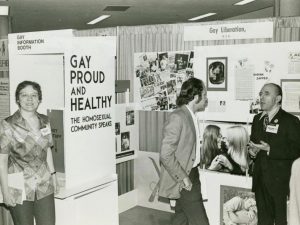
Barbara: Yes! Yes! We had a wonderful headline in one of the Philadelphia papers: “20 Million Homosexuals Gain Instant Cure.” And a picture of me and some little interview with me in the story. But it was basically about the vote. It was a front page story and I was thrilled with it. And it… exactly… we were cured overnight by a stroke of the pen. Just as originally we’d been made sick by probably a stroke of the pen.
Now, the effects were not necessarily felt overnight, but you could see that by the end of the ‘70s, six or seven years after the decision in APA, we were no longer putting so much energy into fighting the psychiatrists and the sickness label.
Eric: And today it’s hardly talked about.
Barbara: It’s hardly talked about. Now it’s okay you… I’d rather… I’d rather… No, but you can argue with people… In a way, you can argue with people who say that you’re immoral because you can say, look, there are so many kinds of morality. There are no absolutes. And you and I will agree on most things and we will disagree on this one, but you can’t enforce your morality on me. The sickness label supposedly had the cachet of indisputable science, which made it a lot harder to deal with in the, with the general public.
It was easy for people to say, “Oh, those people are sick.” And now they had to come up with other reasons. And now they’re coming out with more basic reasons: “I don’t like you.” “I don’t like the way you live.” “I think you’re immoral.” “I think you’re rotten.” Well, all of that is more honest than this nonsense about, “You’re sick.”
———
Eric: Kay’s photograph of the Dr. H. Anonymous panel at the American Psychiatric Association convention in 1972 is one of my all-time favorites from the movement. You can see it at makinggayhistory.com. There’s Barbara Gittings and Frank Kameny looking at the camera and smiling broadly. Next to Frank is Dr. H. Anonymous in a face mask. And at the podium is Dr. Judd Marmor, a psychiatrist.
You have to marvel at how Barbara and Frank, two civilians, got themselves to the center of one of the most pivotal and crucial debates about gay people. Were we sick or not? And they helped win the day. Talk about citizen heroes. They are role models for all of us, especially at a time in our nation’s history where we are all called to action to defend all Americans against the forces of ignorance, fear, and tyranny. Forty-four years after the APA’s vote, there are still people and organizations pushing the idea that homosexuals can be cured through conversion therapy.
Barbara Gittings died on February 18, 2007. Kay lives outside Philadelphia in a retirement community. I have the pleasure of speaking with Kay every now and then and the first thing she always says to me is, “Hello dear, what have you got for me?” Kay can’t be out on the front lines anymore but wants to know what’s going on with us younger folks. If you’d like to get a message to Kay, write to me at hello@makinggayhistory.com and I’ll be sure to get it to her. I know she’d be happy to hear from you.
———
I’ve got a few people to thank for their work on this podcast: executive producer Sara Burningham, co-producer and guardian angel Jenna Weiss-Berman, audio engineer Casey Holford, webmaster Jonathan Dozier-Ezell, head of research Zachary Seltzer, and our social media strategist Will Coley. Our theme music was composed by Fritz Myers.
Before I go, I’d like to tell you about a new podcast from our friends at WNYC Studios. It’s the Nancy podcast, hosted by Tobin Lo and Kathy Tu. As they say, everyone’s a little bit gay. So give them a listen. You’ll find them everywhere podcasts are available.
Making Gay History is a co-production of Pineapple Street Media, with assistance from the New York Public Library’s Manuscripts and Archives Division and the ONE Archives Foundation.
Season two of this podcast is made possible with support from the Ford Foundation, which is on the front lines of social change worldwide.
And if you like what you’ve heard, please subscribe to Making Gay History on iTunes, Spotify, Stitcher, NPR One, or wherever you get your podcasts.
So long. Until next time.
###